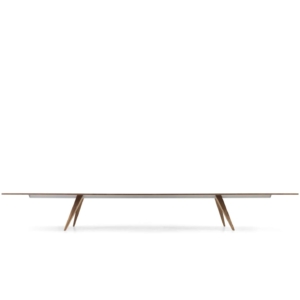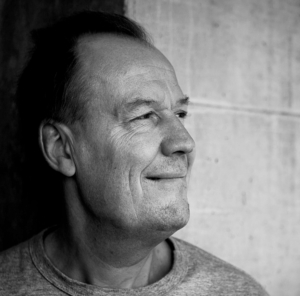This website uses cookies so that we can provide you with the best user experience possible. Cookie information is stored in your browser and performs functions such as recognising you when you return to our website and helping our team to understand which sections of the website you find most interesting and useful.
Interview with Troels Grum-Schwensen, LICC Winner in USE (Product) in the Professional category, discusses the “golden age” of Danish furniture design and how the climate in Scandinavia affected local artists’ methods.
Tell us a little about your background. How did your love of design grow?
As a child, I liked to draw. I also liked to observe how things worked and functioned – not at least in nature, e.g. living creatures (actually, I, in my room, had a lot of small animals, like fish, birds and snakes). Already as a small preschool kid, I knew a lot about the evolution-processes, and the reason why species appear as they do. I loved (and still do) the lush diversity of birds, their shapes and colours.
For me, there is a direct line from this to the interest in giving shape to rooms and objects – and, somehow, also furniture-design develops in evolutionary processes.
In 1978, I began my studies at the Royal Danish Academy of fine arts and graduated from the department of furniture and space in 1986.
Since then, I have eagerly designed lots of spaces, rebuilding’s, extensions and, not at least, hundreds of furniture. Most of the furniture-ideas remains drawings or digital 3D-models and have never been publicized. Around 50 has been built physically, as one-offs, prototypes or products (see; www.grumdesign.com ) Maybe some 15 has been – or are- in production.
What merits do you see in being Winner in Use (product)? What does receiving this award personally mean to you?
For some reason, my design; the PONTO-table – manufactured by LAMMHULTS – seems to have been almost “magnetic” to design-awards and has now, the LICC-award inclusive, achieved no less than 8.
Each of them makes me proud and gives me a hint of doing the right thing, even though the conditions in the furniture-design-field in Denmark can be very tough and one must be steady continuing, despite many years without much success.
What steps do you take in the creative process, and what tools do you use?
I always start with hand-sketches of new ideas – which are very often based on an expression of an innovative construction. Later, I, in cooperation with my computer-drawing-assistant, begins the long-lasting 3D-modelling-work with proportions and growing accuracy in the shape.
Where do you find your inspiration and motivation for your work?
In nature, animal-species, buildings and sometimes in works of the great masters.

Best in USE (Professional): “PONTO Table-system (meeting-tables)” by Troels Grum-Schwensen
What design endeavor would you most like to pursue?
My designs should be meaningful and have substance, integrity, character – and possess sculptural qualities. There are so many chairs and other products in the world and there is no reason to add one more, unless it contributes with something valuable; new way of functioning, new material-minimized construction, less damage to the environment or new aesthetic and emotional appearance.
What impact do you believe your own culture and environment have had on your creative vision both personally and professionally?
In Denmark we have, for good and bad, a rather ascetic tradition. In the “golden age” of Danish furniture-design, this resulted in some very thoroughly, carefully worked through, spaces and furniture. I think it’s not possible to work in the furniture-design-field in Denmark, without being influenced of the masters from that period – and their beliefs. Also, the climate in Scandinavia has stimulated craftsmen and creatives to carefully work with their objects for a long time. In a sense, the global climate problems have made this caring approach more actual than ever.
Tell us about a project that you feel has been your most successful achievement.
Maybe this is my ATTACH table-system, manufactured by LAMMHULTS. This furniture-system unites the advantages from special one-off-designs with the ones from a serial industrial production. ATTACH is almost a benchmark when it comes to the possibilities to customize large industrial furniture. It can be ordered in any shape and in length and width by centimetre. Furthermore, my innovation; the principle of gravity-locked legs (also, in a differing way, used in PONTO), enables the user with a freedom to – without the use of tools – move the leg to the position most optimal for the chosen chairs, the sitting humans, the specific space, and aesthetical preferences.
Being an Architect, it is of great importance to me that large spatial objects can be perfectly adapted to the specific architectural space. A space must be friendly to the human users by providing them with the right amount of free space around a large object. It’s a question of balance and well-being.
Which photographers and designers in your industry do you most admire, and why?
I admire Mies, Eames, Aalto, Finn Juhl, Kjaerholm and many more.
How do you think design has changed over time, and how do you envision it changing moving forward?
The care of the environment and nature must get a higher priority in all senses of designing.
What do you believe to be the current significant possibilities and problems in your field?
The possibilities have to relate closely to the situation for the environment and our climate. In some cases, e.g., the attention to easy separation of material after a lifespan of a product, can also be a possibility to sharpen and clarify the visual expression of material-distinction – like in my LICC-winning PONTO-table.
Furthermore, to the growing needs for adaptability, coming with the changes in conditions for working etc.
The problems are related to fashion and trends coming so much into the design-field. For instance, some “trendsetting” Danish furniture-brands has now for more than 15 years repeated almost identical, rather boring, designs. Most of them produced in the slow-growing oak-wood, which should be reserved to purposes where its specific abilities are needed. Now this wood-species are in some areas close to extinction because of this trend with Oak used so much in phrased repeating’s of idea-abandoned, trendy furniture. To me, it seems that trends and fashion are exploited as consumption-promotional business-tools and among the worst enemies of substantial and long-lasting quality-design.
What are you working on right now, if you could give us a sneak peek?
I always passionate and idealistic work with sketching on several new ideas for sculptural or innovative furniture-designs of all kinds. At the same time, I, with many hardly paid hours to my computer-assistant, work with the very long-lasting processes to give some of the furniture-ideas the right shape, proportions, and details.
Until I know if and how – some of – these, for a large part, unrequested projects will be launched or exhibited, they will have to remain confidential.
View the winning project of Troels Grum-Schwensen here.
© 2024 London International Creative Competition




Recent Comments